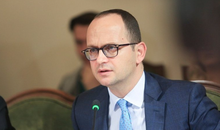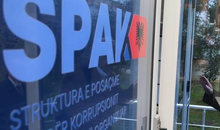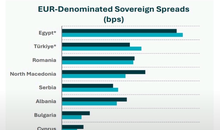
 Flash News
Flash News
Drenova prison police officer arrested for bringing drugs and illegal items into cell
Lavrov: NATO is risking self-destruction with new military budget
Kurti and Vučić "face off" tomorrow in Skopje
Construction worker dies after falling from scaffolding in Berat
The prosecution sends two Korça Municipality officials to trial
BIRN: Instead of investments, municipalities inflate their staffs with workers

The number of budget employees in local government units reached 37 thousand in 2023, with an increase of 12% compared to 2019 and with an increase of almost 90% compared to 2015. The dramatic increase in the number of employees in local government throughout the decade the latter comes at a time when the actual population present in the territory of almost all municipalities has decreased, which means the need for fewer workers to perform services compared to the remaining population.
Official data analyzed by BIRN show that the number of employees in local government units before the 2015 reform was only 20 thousand, while in 2023 it has increased to 37 thousand. The main reason for the 2015 reform was that, through the reduction of local government units from 394 to 61, administrative costs could be reduced and funds available for investment in roads, water supply or sewerage, or to create the collection system and waste processing, these key functions of local government.
Local government has been administered by socialist mayors from 2019 to 2023 in sixty out of sixty-one municipalities, Shkodra being the only exception. The 2019-2023 mandate was created after the main opposition refused to participate in the 2019 elections, which led to the Socialists controlling not only mayors but also the vast majority of city councils.
During this mandate, the number of employees in the local government increased from 33 thousand to 37 thousand or by 13%. In 50 of the country's 61 municipalities, the mandate was accompanied by an increase in the number of employees, while it is assumed that the local government needs to increase investments for basic public services, water supply, sewerage, rural roads or cleaning and greening. In thirteen municipalities, in fact, the increase in the number of employees is no greater than 5% for four years, while in only 11 municipalities, the number of actual employees did not increase or suffered a decrease. Most of the municipalities in which the number decreased or did not increase significantly are actually small municipalities in terms of population.
The number of employees at the local level is generally difficult to find and the municipalities themselves rarely have a sufficient level of transparency about how many staff they have and what the staff they have is for or how much it costs to keep these workers. Moreover, in addition to municipal staff, municipalities also have companies under ownership, such as water utilities, which, being separate companies and not budget agencies, have corresponding staff not included in these figures. The figures for 2023 were published on the website of the Parliament of Albania as part of the draft law on the Actual Budget. These data have been rarely published by the Ministry of Finance during the past years, so it is not possible to observe in which year specifically the employees were added. Consequently, data on the number of budget employees in the municipality are available only for the years 2018, 2019 and 2023.
Public sector employees in Albania are divided into "budgetary" and "non-budgetary", where in the first category are employees whose salary is covered by taxes paid by citizens, while the "non-budgetary" sector includes employees in publicly owned companies , who receive their salaries from the payments of citizens and businesses in exchange for services or goods sold by these companies. The division is not clear-cut anyway because many of the publicly owned companies are often loss-making and are subsidized by budgets paid through the taxation system. So, for example, football companies are largely subsidized by municipal budgets, despite the fact that in theory they are separate companies, and likewise, water supply companies receive subsidies, which, in theory, should serve to carry out the necessary investments for supply with water despite the fact that they practically end up paying inflated staff.
The municipality of Kamza, which is governed by the Socialist Party since 2019, has increased the number of employees by 70%, from 643 people four years ago, to 1094 people in 2023. The municipality, which currently supplies 96 thousand its residents with only four hours of water and that, for the supply of water, for which, for several years now, they have not paid the cost of the Tirana Waterworks and Sewerage that serves as a wholesale supplier, obviously saw it as a priority to increase the number of employees instead of investments for increasing the quality of water supply.
The municipality of Devoll ranks second with an increase in the number of employees by 50% compared to four years ago, while the municipality of Vlora, which, during the last decade, has lost 20% of its population and whose water supply is already notorious throughout the country and where the water company has accumulated over 80 million euros in debt, it has seen fit to increase the number of employees by 34%. Currently, 1,339 people receive a salary in this municipality.
The municipality of Tirana is the largest municipality in the country in terms of population and here, the number of employees over the last four years has increased by 20%. Today, 8112 people work as budget employees in this municipality. This figure does not include several thousand others who work in companies owned by the municipality, who are in the "non-budgetary" category.
Elbasan and Berat are among the few large municipalities which, during the last four years, have not seen a significant increase in budget employees.
At the national level, Tirana is the municipality with the largest number of budget employees with 8112 people, followed by Durrës with 1779 and Elbasan with 1412 employees. The municipality of Pustec is the smallest with 83 employees, while that of Libohova has 91 employees.
The comparison of the number of budgetary employees of the municipalities with the number of the resident population counted by the Census 2023, shows that the small municipality of Fushë-Arrëzi in the north holds the record with 238 employees for less than 5 thousand inhabitants. In this municipality, almost one in twenty residents is employed in the municipality. Not far behind is the neighboring municipality of Puka, where 294 people are employed for a little more than 6,200 inhabitants, or Pusteci, where there are 83 employed for 1,843 inhabitants.
The municipality of Shkodra, which during the 2019-2023 mandate was the only municipality under the control of the opposition, has a positive record. In this municipality with 102 thousand inhabitants, during this period there were 979 budget employees or less than 1 in every 100 inhabitants. On average, at the national level, municipalities have 1.5 budget employees for every 100 inhabitants.
The number of employees in the public sector as a whole has increased dramatically over the last decade, apparently because the government has a tendency to increase salaries in exchange for votes, despite the fact that the country's population has declined. According to the latest INSTAT data, the public sector currently has 183 thousand employees, with an increase of 20 thousand employees compared to 2016. The high number of employees in the public sector and the salaries that these additional employees eat from the state budget necessarily erode the capacities for public investments, investments which, in a normal situation, would help the country not only to have better quality public services in water supply, roads or sewerage, but would help to accelerate the country's economic growth. Despite the increase in the number of employees in the state, the number of the population currently living in Albania has fallen from slightly more than 2.8 million inhabitants to only 2.4 million between 2011 and 2023, which, logically, would require a proportional reduction in the number of employees in the public sector./ BIRN
Latest news



Second hearing on the protected areas law, Zhupa: Unconstitutional and dangerous
2025-06-30 22:18:46



Israel-Iran conflict, Bushati: Albanians should be concerned
2025-06-30 21:32:42

Fuga: Journalism in Albania today in severe crisis
2025-06-30 21:07:11
"There is no room for panic"/ Moore: Serbia does not dare to attack Kosovo!
2025-06-30 20:49:53

Temperatures above 40 degrees, France closes nuclear plants and schools
2025-06-30 20:28:42
Lavrov: NATO is risking self-destruction with new military budget
2025-06-30 20:13:54
Turkey against the "Bektashi state" in Albania: Give up this idea!
2025-06-30 20:03:24

Accused of sexual abuse, producer Diddy awaits court decision
2025-06-30 19:40:44



Kurti and Vučić "face off" tomorrow in Skopje
2025-06-30 18:44:12
Tourism: new season, old problems
2025-06-30 18:27:23


Construction worker dies after falling from scaffolding in Berat
2025-06-30 17:51:44




Almost free housing: East Germany against depopulation
2025-06-30 16:43:06

Hamas says nearly 60 people killed in Gaza as Trump calls for ceasefire
2025-06-30 16:14:15
Drownings on beaches/ Expert Softa: Negligence and incompetence by institutions!
2025-06-30 16:00:03


European ports are overloaded due to Trump tariffs
2025-06-30 15:30:44
The prosecution sends two Korça Municipality officials to trial
2025-06-30 15:19:54

Lezha/ Police impose 3165 administrative measures, handcuff 19 drivers
2025-06-30 14:55:04
Young people leave Albania in search of a more sustainable future
2025-06-30 14:47:52
Record-breaking summer, health threats and preventive measures
2025-06-30 14:36:19


Constitution of the Parliament, Osmani invites political leaders to a meeting
2025-06-30 14:07:54

Heat wave 'invades' Europe, Spain records temperatures up to 46 degrees Celsius
2025-06-30 13:42:02
Accident in Vlora, car hits 2 tourists
2025-06-30 13:32:16

Kurti confirms participation in today's official dinner in Skopje
2025-06-30 13:03:27

Fight between 4 minors in Kosovo, one of them injured with a knife
2025-06-30 12:38:45

Report: Teenage girls the loneliest in the world
2025-06-30 12:20:40
Commissioner Kos and Balkan leaders meet in Skopje on Growth Plan
2025-06-30 12:07:59
Wanted by Italy, member of a criminal organization captured in Fier
2025-06-30 11:55:53
Hundreds of families displaced by wave of Israeli airstrikes in Gaza
2025-06-30 11:45:17

Zenel Beshi: The criminal who even 50 convictions won't move from Britain
2025-06-30 11:23:19
A new variant of Covid will circulate during the summer, here are the symptoms
2025-06-30 11:14:58


"Partizani" case, trial postponed to July 21 at the Special Court
2025-06-30 10:41:05
Uncontrolled desire to steal, what is kleptomania, why is it caused
2025-06-30 10:30:08
Requested change of security measure, hearing for Malltez postponed to July 7
2025-06-30 10:24:32


Output per working hour in Albania 35% lower than the regional average
2025-06-30 09:54:35


The trial for the "Partizani" file begins today
2025-06-30 09:27:57
22 fires in the last 24 hours in the country, 2 still active
2025-06-30 09:21:28
How is the media controlled? The 'Rama' case and government propaganda
2025-06-30 09:13:36
German top diplomat: Putin wants Ukraine to capitulate
2025-06-30 09:00:07
Foreign exchange, how much foreign currencies are sold and bought today
2025-06-30 08:44:38
Chart/ Sovereign risk for Albania from international markets drops significantly
2025-06-30 08:26:38
Horoscope, what do the stars have in store for you?
2025-06-30 08:11:44
Clear weather and passing clouds, here is the forecast for this Monday
2025-06-30 07:59:32
Morning Post/ In 2 lines: What mattered yesterday in Albania
2025-06-30 07:47:37
Milan make official two departures in attack
2025-06-29 21:57:23
6 record tone
2025-06-29 21:30:46
4-year-old girl falls from balcony in Lezha, urgently taken to Trauma
2025-06-29 21:09:58


Assets worth 12 million euros seized from cocaine trafficking organization
2025-06-29 19:39:43
Fire in Durrës, Blushi: The state exists only on paper
2025-06-29 19:17:48

Fire endangers homes in Vlora, helicopter intervention begins
2025-06-29 18:27:51
France implements smoking ban on beaches and parks
2025-06-29 18:02:08
England U-21 beat Germany to become European champions
2025-06-29 17:42:49
Trump criticizes Israeli prosecutors over Netanyahu's corruption trial
2025-06-29 17:08:10
Street market in Durrës engulfed in flames
2025-06-29 16:52:57

UN nuclear chief: Iran could resume uranium enrichment within months
2025-06-29 16:03:24
Albanian man dies after falling from cliff while climbing mountain in Italy
2025-06-29 15:52:01

Another accident with a single-track vehicle in Tirana, a car hits a 17-year-old
2025-06-29 15:07:15
While bathing in the sea, a vacationer in Durrës dies
2025-06-29 14:54:01
Sentenced to life imprisonment, cell phone found in Laert Haxhiu's cell
2025-06-29 14:26:40
77 people detained in protest, Vučić warns of new arrests
2025-06-29 14:07:46

